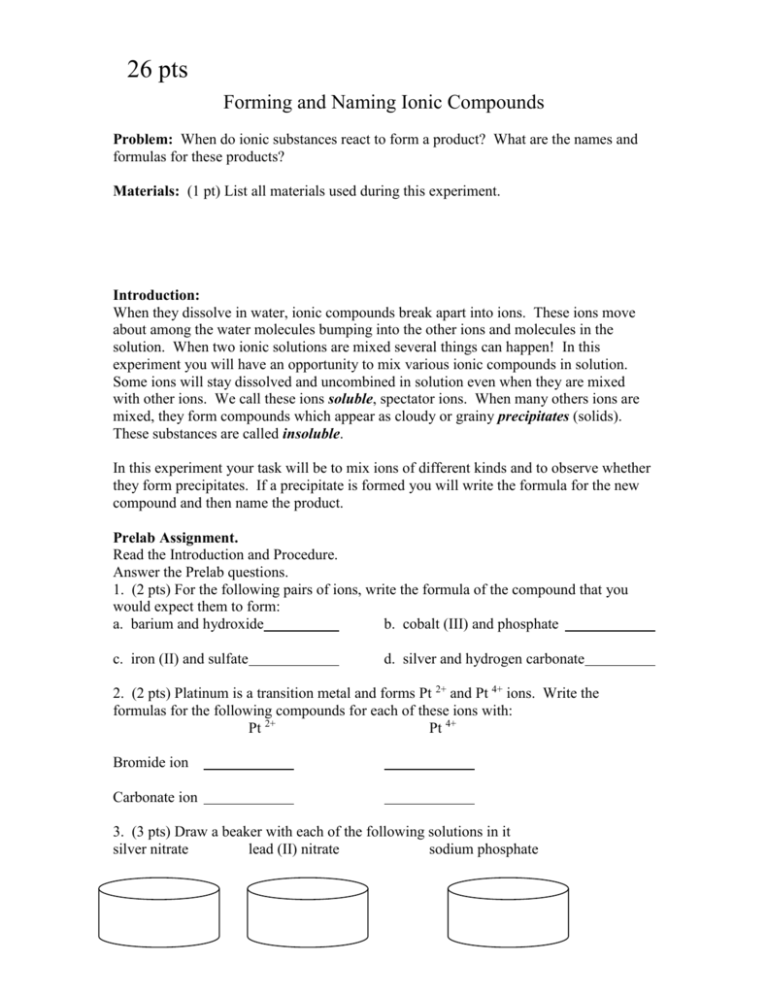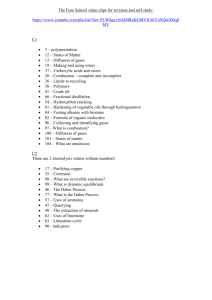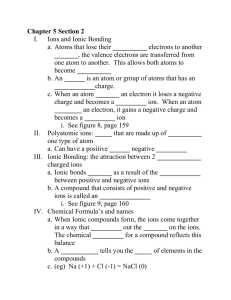forming and naming ionic compounds lab
advertisement

26 pts Forming and Naming Ionic Compounds Problem: When do ionic substances react to form a product? What are the names and formulas for these products? Materials: (1 pt) List all materials used during this experiment. Introduction: When they dissolve in water, ionic compounds break apart into ions. These ions move about among the water molecules bumping into the other ions and molecules in the solution. When two ionic solutions are mixed several things can happen! In this experiment you will have an opportunity to mix various ionic compounds in solution. Some ions will stay dissolved and uncombined in solution even when they are mixed with other ions. We call these ions soluble, spectator ions. When many others ions are mixed, they form compounds which appear as cloudy or grainy precipitates (solids). These substances are called insoluble. In this experiment your task will be to mix ions of different kinds and to observe whether they form precipitates. If a precipitate is formed you will write the formula for the new compound and then name the product. Prelab Assignment. Read the Introduction and Procedure. Answer the Prelab questions. 1. (2 pts) For the following pairs of ions, write the formula of the compound that you would expect them to form: a. barium and hydroxide b. cobalt (III) and phosphate c. iron (II) and sulfate d. silver and hydrogen carbonate 2. (2 pts) Platinum is a transition metal and forms Pt 2+ and Pt 4+ ions. Write the formulas for the following compounds for each of these ions with: Pt 2+ Pt 4+ Bromide ion Carbonate ion 3. (3 pts) Draw a beaker with each of the following solutions in it silver nitrate lead (II) nitrate sodium phosphate Safety Wear your safety goggles at all times in the laboratory. Long haired people, make sure your hair is tied back. Baggy sleeved people, get them under control. Procedure: 1. Obtain a transparency and reaction grid. Place the reaction grid under the transparency and then tape it down. 2. Place one drop of the solution into each of its squares. MAKE SURE THE DROP(S) FALL TO THE TRANSPARENCY. Repeat until finished. The Droppers must be put back where they came from. 3. Observe each well very carefully. Record if a precipitate forms and its color on your data table. If you are unsure that a precipitate has formed, then use a toothpick to stir the mixture. The toothpick must be new for each mixture. If nothing has happened then write NR (no reaction) in that box. Cleaning Up 1. Carefully rinse the transparency into the waste bottle. Then throw the transparency away. 2. Wash down your lab station and then your hands. 3. Check out. Data Table (5 pts) Analysis and Conclusion 1. (10 pts) Write the name and formula for 10 cases in which you observed a reaction. You can do this on your data table if you write smaller. 2. (3 pts) Discuss what you learned, sources of error, and a real world application.







